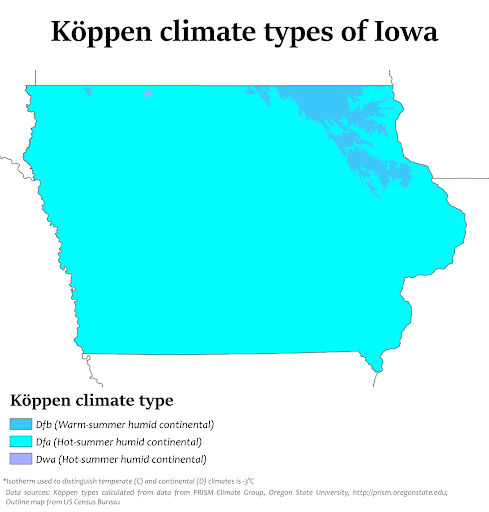Köppen Climate Classifications
Climate covers everything from averages to extremes of different meteorological variables, such as temperature and precipitation. Köppen’s climate classifications give information about these different variables.
The majority of Iowa falls within the Humid Continental (Dfa) climate classification, with varying climate zones within the northern portions of the state.
This climate zone has warm-to-hot (humid) summers with cold (sometimes
bitterly cold) winters. The average temperature of the warmest month
is 71.6°F (22˚C). There is usually no dry season with this
classification, and the rainfall is evenly distributed throughout
the year.
This climate zone has an average temperature in the warmest month below 72˚F
(22 °C) and the average temperatures in the coldest month are generally far
below the 27˚F (−3 °C). Summer high temperatures in this zone typically
average between 70–82 °F (21–28 °C) during the daytime. There is only about
a 3-5 month frost-free period, and heat waves rarely last over a week.
This climate classification s limited to the Northern Hemisphere and is a hot
summer version of a continental climate. This regime features an average
temperature of at least 22 °C (71.6 °F) in its warmest month, usually July
or August. High temperatures in the warmest month tend to be in the upper
20s or low 30s °C (80s or low 90s °F), while average January afternoon
temperatures are near or well below freezing. Frost-free periods usually
last 4–7 months within this climate regime. Precipitation can be uniform
throughout the year or have one specific wet-season.
Because of Iowa's unique geography and location, its climate is the marked temperature contrast between summer and winter, with four distinct seasons. Let's explore the influences on the climatic zones for Iowa.

Source: Wikipedia